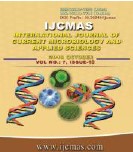


 National Academy of Agricultural Sciences (NAAS)
National Academy of Agricultural Sciences (NAAS)

|
PRINT ISSN : 2319-7692
Online ISSN : 2319-7706 Issues : 12 per year Publisher : Excellent Publishers Email : editorijcmas@gmail.com / submit@ijcmas.com Editor-in-chief: Dr.M.Prakash Index Copernicus ICV 2018: 95.39 NAAS RATING 2020: 5.38 |
The proximate composition of twenty one small indigenous species (SIS) viz. Baim (Mastacembelus armatus), Bele/Bailla (Glossogobius giuris), Kholisha (Colisa fasciata), Nama Chanda (Chanda nama), Ranga Chanda (Parambassis ranga), Folui (Notopterus notopterus), Gulsha Tangra (Mystus cavasius), Guchi (Mastacembelus pancalus) Sor Punti (Puntius sophore), Koi (Anabas testudineus), Magur (Clarias batrachus), Meni (Nandus nandus), Morala (Amblypharyngodon mola), Rani/Bou (Botia Dario), Shinghi (Heteropneustes fossilis), Taki (Channa punctatus), Tara Baim (Macrognathus aculeatus), Tangra (Mystus vittatus), Tit Punti (Puntius ticto), Shol (Channa striatus), Chitol (Notopterus chitala) available in Paschim Medinipur district of West Bengal were analyzed to assess their nutritive value. Major nutrient composition of different small indigenous fishes (SIS) like protein, lipid, moisture, ash and carbohydrate were estimated by standard methods. The crude protein content ranged between 13.86% and 19.17% with the highest protein was found in shinghi (H. fossilis) and lowest in kholisha (C. fasciata). Likewise, the lipid content varied from 1.18% (H. fossilis) to 5.21% (B. dario). Moisture content show a discrepancy from 72.65% (P. sophore) to 79.71% (C. punctatus). Other nutrients such as carbohydrate content varies from 1.05% (N. chitala) to 4.95% (A. testudineus) whereas, the ash content varied from 1.38% (C. batrachus) to 4.35% (P. ticto). From the present study, it could be concluded that the SIS are the cheap source of quality protein and major micronutrients thereby safeguarding both nutritional and livelihood security as well as the protein hunger.
 |
 |
 |
 |
 |